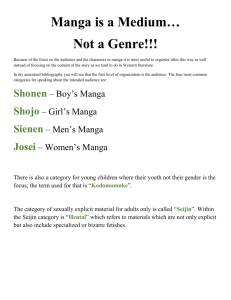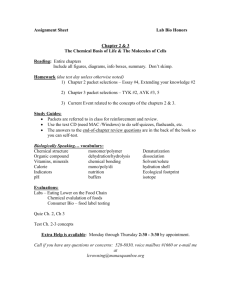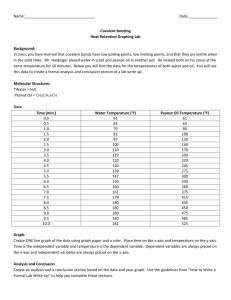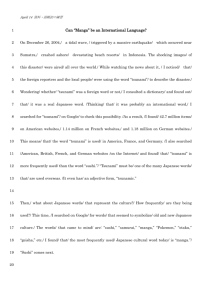Advance Journal of Food Science and Technology 7(12): 914-920, 2015
advertisement
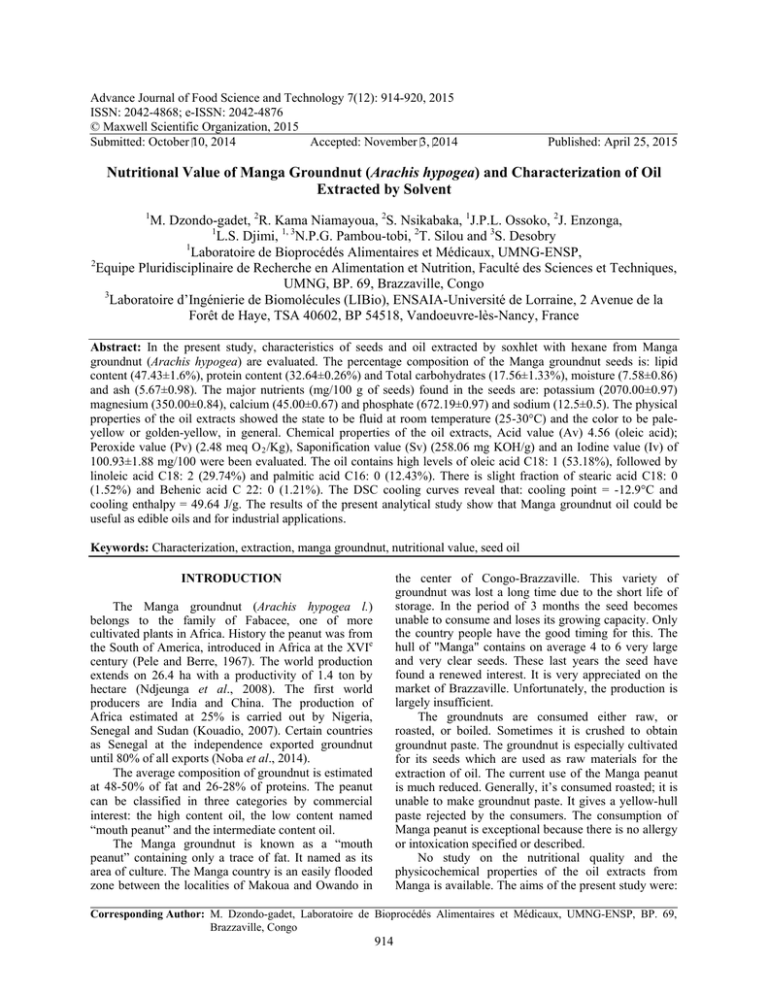
Advance Journal of Food Science and Technology 7(12): 914-920, 2015 ISSN: 2042-4868; e-ISSN: 2042-4876 © Maxwell Scientific Organization, 2015 Submitted: October 10, 2014 Accepted: November 3, 2014 Published: April 25, 2015 Nutritional Value of Manga Groundnut (Arachis hypogea) and Characterization of Oil Extracted by Solvent 1 M. Dzondo-gadet, 2R. Kama Niamayoua, 2S. Nsikabaka, 1J.P.L. Ossoko, 2J. Enzonga, 1 L.S. Djimi, 1, 3N.P.G. Pambou-tobi, 2T. Silou and 3S. Desobry 1 Laboratoire de Bioprocédés Alimentaires et Médicaux, UMNG-ENSP, 2 Equipe Pluridisciplinaire de Recherche en Alimentation et Nutrition, Faculté des Sciences et Techniques, UMNG, BP. 69, Brazzaville, Congo 3 Laboratoire d’Ingénierie de Biomolécules (LIBio), ENSAIA-Université de Lorraine, 2 Avenue de la Forêt de Haye, TSA 40602, BP 54518, Vandoeuvre-lès-Nancy, France Abstract: In the present study, characteristics of seeds and oil extracted by soxhlet with hexane from Manga groundnut (Arachis hypogea) are evaluated. The percentage composition of the Manga groundnut seeds is: lipid content (47.43±1.6%), protein content (32.64±0.26%) and Total carbohydrates (17.56±1.33%), moisture (7.58±0.86) and ash (5.67±0.98). The major nutrients (mg/100 g of seeds) found in the seeds are: potassium (2070.00±0.97) magnesium (350.00±0.84), calcium (45.00±0.67) and phosphate (672.19±0.97) and sodium (12.5±0.5). The physical properties of the oil extracts showed the state to be fluid at room temperature (25-30°C) and the color to be paleyellow or golden-yellow, in general. Chemical properties of the oil extracts, Acid value (Av) 4.56 (oleic acid); Peroxide value (Pv) (2.48 meq O 2 /Kg), Saponification value (Sv) (258.06 mg KOH/g) and an Iodine value (Iv) of 100.93±1.88 mg/100 were been evaluated. The oil contains high levels of oleic acid C18: 1 (53.18%), followed by linoleic acid C18: 2 (29.74%) and palmitic acid C16: 0 (12.43%). There is slight fraction of stearic acid C18: 0 (1.52%) and Behenic acid C 22: 0 (1.21%). The DSC cooling curves reveal that: cooling point = -12.9°C and cooling enthalpy = 49.64 J/g. The results of the present analytical study show that Manga groundnut oil could be useful as edible oils and for industrial applications. Keywords: Characterization, extraction, manga groundnut, nutritional value, seed oil the center of Congo-Brazzaville. This variety of groundnut was lost a long time due to the short life of storage. In the period of 3 months the seed becomes unable to consume and loses its growing capacity. Only the country people have the good timing for this. The hull of "Manga" contains on average 4 to 6 very large and very clear seeds. These last years the seed have found a renewed interest. It is very appreciated on the market of Brazzaville. Unfortunately, the production is largely insufficient. The groundnuts are consumed either raw, or roasted, or boiled. Sometimes it is crushed to obtain groundnut paste. The groundnut is especially cultivated for its seeds which are used as raw materials for the extraction of oil. The current use of the Manga peanut is much reduced. Generally, it’s consumed roasted; it is unable to make groundnut paste. It gives a yellow-hull paste rejected by the consumers. The consumption of Manga peanut is exceptional because there is no allergy or intoxication specified or described. No study on the nutritional quality and the physicochemical properties of the oil extracts from Manga is available. The aims of the present study were: INTRODUCTION The Manga groundnut (Arachis hypogea l.) belongs to the family of Fabacee, one of more cultivated plants in Africa. History the peanut was from the South of America, introduced in Africa at the XVIe century (Pele and Berre, 1967). The world production extends on 26.4 ha with a productivity of 1.4 ton by hectare (Ndjeunga et al., 2008). The first world producers are India and China. The production of Africa estimated at 25% is carried out by Nigeria, Senegal and Sudan (Kouadio, 2007). Certain countries as Senegal at the independence exported groundnut until 80% of all exports (Noba et al., 2014). The average composition of groundnut is estimated at 48-50% of fat and 26-28% of proteins. The peanut can be classified in three categories by commercial interest: the high content oil, the low content named “mouth peanut” and the intermediate content oil. The Manga groundnut is known as a “mouth peanut” containing only a trace of fat. It named as its area of culture. The Manga country is an easily flooded zone between the localities of Makoua and Owando in Corresponding Author: M. Dzondo-gadet, Laboratoire de Bioprocédés Alimentaires et Médicaux, UMNG-ENSP, BP. 69, Brazzaville, Congo 914 Adv. J. Food Sci. Technol., 7(12): 914-920, 2015 to examined the nutritional value of the Manga peanut and (2) to describe the physico-chemical properties, fatty acid profiles, viscosity and DSC analysis of Manga peanut oil. Determination of fatty acid composition: The analysis of fatty acids in the seed oil was carried out following the method described by Ackman (1998). The Fatty Acid Methyl Esters (FAME) composition was determined by the conversion of oil to fatty acid methyl esters prepared by adding 1.5 mL of n-hexane to 100 mg of oil followed by 1.5 mL of mixture borontrifluoride in methanol (8% w/v) The mixture was heated in the bath at 100°C for 1 h previously to submit the samples to gas chromatography analysis. The analysis of FAMEs was carried out on a gas chromatography (CG-2010 Plus, Shimadzu) equipped with a Flame Ionization Detector (FID) and a capillary column (60 m, 0.25 mm i.d.,×0.20 µm film thicknesses). Oven temperature was set at 200°C, detector and injector temperatures were at 250°C. Helium was the carrier gas at a flow rate of 0.79 mL/min. A temperature program of column was initially set at 120°C for 2 min, then rose to 180°C for 2 min at a rate of 2°C/min and kept at 220°C for 25 min. The fatty acids were identified by comparison of their retention times with appropriate standards (PUFA 2 from vegetable source; Supelco, Sigma-Aldrich, Bellefonte, PA, USA). The percentage of FAMEs was calculated from the total area of all peaks. MATERIALS AND METHODS Seeds and oil extraction: All seeds used in this study were obtained from Makoua (Center of CongoBrazzaville). Prior to analysis, all seeds (stored at cool and dry place) were brought to room temperature for a minimum of 24 h. Samples of peanut seeds were crushed in a coffee grinder (Moulinex model SeB PREP’LINE 850). Thirty gram of ground seed were placed into a cellulose paper cone and extracted using n-Hexane (60°C) in a 250 mL soxlhet extractor for 6 h. The solvent was removed using rotary evaporator model Heidolph, laborota 4000 (Tuttlingen, Germany) at 50°C. Residual solvent was removed by drying in flushing with 99.9% nitrogen. Proximal composition: Proximate composition in levels of lipid, moisture, crude protein (micro-Kjeldahl N×6.25), crude fibers were determined according to Pearson (1976) methods. The level of ash was determined also by current methods (Pomeraz and Meloan, 1994). Total carbohydrate was obtained by difference. The minerals were determined by atomic absorption spectrophotometry (Perkin-Elmer, model 2380, USA). One gram of matter dry ashed in muffle furnance at 550°C for 8 h until, a white residue of constant weight was obtained. The minerals were extracted from ash by adding 20 mL of 2.5% HCl heated in a steam bath to reduce the volume to about 7.0 mL and this was transferred quantitatively to 50 mL volumetric flask. It was diluted with deionised water, stored in clean polyethylene bottles and mineral content. The instrument was calibrated with standards solutions. The indices of manga peanut oil: Standards methods AOAC (Association Official Analytical Chemists) were used for the determination of the acid value (method 969.1), peroxide value (method 920.160), iodine value (method 993.20) and saponification value (method 965.33) of oil. Thermal behavior of manga peanut oil: Thermal analyses were performed with a Perkin-Elmer Differential Scanning Calorimeter, DSC-7, equipped with a thermal analysis data station (Perkin-Elmer Corp, Norwalk, CT, USA). Nitrogen was the purge gas and flowed at 20 mL/min. The calorimeter was calibrated according to standard procedures established in the manufacturer user book using indium and distilled water. Samples of 15 mg were weighed into aluminium pans with an empty pan used as a reference. The sample and reference pans were then placed inside the calorimeter and cooled and/or heated at 2.5°C/min from -60 to +60°C. The heat-of-fusion enthalpies ΔH (J/g) were calculated for each peak by the Pyris software (Perkin-Elmer Corp, Norwalk, CT, USA). DSC measurements were carried out in triplicate. Color determination: The color of peanut seeds was measured using a microflash 200 days (datacolor International) and expressed as color L* (lightness), a* (redness) and b* (yellowness) values CIELAB (CIE, 1986). The difference of color between the references was determined by the following equation: ∆E = [(Lt - L 0 )2 + (at - a 0 )2 + (bt - b 0 0)2]1/2 The color of the oil was determined using the Lovibond Tintometer (Lovibond PFX195, VWR International France). Each sample was taken in a cube and placed in the space provided in the tintometer. A sample of 5 mL was analyzed at 45°C (Atanu et al., 2008) and the Gardner color was automatically read on the Lovibond Tintometer. The Gardner color scale is from 1 to 18 with 1 containing the least amount of color and 18 with the maximum amount of color. Viscosity measurement: The dynamic viscosity of Manga peanut oil was measured with a Malvern Kinexus Pro. Samples were paced in a CP2/50 SC0029SS plateau; with a temperature increasing from 5 to 45°C, at 1°C/min. The applied stress was constant at 50/S Pa (Souhail-Besbes et al., 2007). 915 Adv. J. Food Sci. Technol., 7(12): 914-920, 2015 The analytical methods: All analysis was carried out in triplicate. The values of different parameters were expressed as the mean±Standard Deviation (x±S.D.). Student’s t test was used for statistical validity of results of viscosity and the coefficient of variation between each measurement do not exceeded 2%. RESULTS AND DISCUSSION The total composition of oil: The results of the proximate composition of Manga peanut (Fig. 1) are shown in Table 1. Seeds of Manga peanut are composed of 47.43%, of oil (dry weight basis), 7.58% of moisture, 5.67% of ash, 17.56% of carbohydrate and 32.64% of crude protein. It could be also classified as oleo proteaginous seeds, rich in minerals. These values indicate that the seeds investigated are good oil seeds, especially when compared with to another study by Onyeike and Acheru (2002). But it’s noted that, the ash, fat, moisture and protein contents are slightly greater than the values determined for seeds groundnut in the study of the same authors. The human body requires a number of minerals in order to maintain good health. Mineral concentrations of the Manga groundnut (Table 1) show that the seeds have a high level of potassium, 2070 mg/100 g, followed by phosphate, 672 mg/100 g, magnesium, 350 mg/100 g, calcium, 45 mg/100 g and sodium, 12.5 mg/100 g. Potassium is an essential mineral element which helps to regulate blood pressure, while calcium is needed for bone growth and muscle contraction and in blood clotting. Magnesium works with calcium to maintain healthy bones. Calcium is also very important in the maintenance of a healthy heart. Manga groundnut is, in general, good sources of minerals and a diet containing these groundnut seeds will help prevent deficiency of these cations and anions. When we compare the Manga and the neighboring cultivars close to Congo-Brazzaville as Teke and Bembe, we found a slight differences. While the cultivar of Teke known as “mouth peanut” yield only 30.43% of fats, the Bembe cultivar yield 47.47% of fats (Table 2 and Fig. 1). Fig. 1: The manga peanut Table 1: Proximal composition of manga peanut Parameters Level (%) Moisture 7.58±0.86 Lipid 47.43±1.60 32.64±0.26 Protein (N T ×6.25) Ash 5.67±0.98 Total carbohydrates 17.56±1.33 Minerals (mg/100 g) Potassium 2070.00±0.97 Phosphates 672.19±0.97 Calcium 45.00±0.67 Sodium 12.50±0.50 Magnesium 350.00±0.84 Values are mean±standard deviation of triplicate determinations; Carbohydrate obtained by difference In the state of Ogun (Nigeria), some cultivars shows a little oil content up to 10.54% (Amos-Tautau et al., 2013). In Congo Brazzaville, the current varieties of peanut contain 30 to 50% of lipids and could not be classified as in high fat content (Silou, 2014). This was for the level cultivar containing over 70% of fats (O’Keefe et al., 1993). Some cultivars as Manga with 47.43±1.6% of oil are in the range of these values. The level of proteins in peanut of Senegal can vary from 26 to 28% (Noba et al., 2014). Then the Manga, which slightly higher rate (32.64±0.26%) lead to a greater nutritional value. Generally, the peanut is source of Phosphorus, Potassium and Magnesium (Anses, 2012). The Manga peanut does not derogate, with Table 2: Fatty acids composition of some congolese groundnut cultivars Fatty acids Manga Teke reported values Bembe reported values Yield 47.43±1.60 30.43 47.47 C10: 0 0.79±0.130 C16: 0 12.43±1.52 10.60 10.70 C18: 0 1.52±0.66 2.73 4.32 C20: 0 0.88±0.12 C22: 0 1.21±0.45 C24: 0 1.60 1.40 ∑SFA 16.83±1.56 14.93 16.42 C18: 1n-9 53.18±2.94 47.50 40.25 C20: 1n-9 0.48±0.02 C22: 1n-9 0.19±0.01 ∑MUFA 53.85±1.00 47.50 40.25 C18: 2n-6 29.32±3.02 30.00 35.20 ∑PUFA 29.32±3.02 30.00 40.25 PUFA/SFA 1.74 2.01 2.51 Reported values Silou (2014); SAFA: Saturated fatty acids; MUFA: Monounsaturated fatty acids; PUFA: Polyunsaturated fatty acid 916 Adv. J. Food Sci. Technol., 7(12): 914-920, 2015 Table 3: Color assessment Nature L* a* Oil 79.65±5.26 -2.97±0.33 b* 33.13±4.39 for a long period without deterioration. According to Ojeh (1981) reported by Onyeike and Acheru (2002) and Ajayi et al. (2007), oils with high peroxide values are unstable and easily become rancid (having a disagreeable odour). Pearson (1976) cited by the same authors also reported that fresh oils have been shown to have peroxide values below 10 mg/g oil and oils become rancid when the peroxide value ranges from 20.0 to 40.0 mg/g oil. Acid value can be used as a measure of oil quality and is positively correlated with FFA content. Ekpa and Ekpe (1995) reported by Onyeike and Acheru (2002) indicate that the AV is the preferred quality control parameter used by paint manufacturers to monitor the concentrations of acids in resins. In this study, the oil extracted from Manga groundnut seeds has the acid value of 4.56±0.41 mg NaOH/g. The initial value of acidity (4.56±0.41 mg NaOH/g) was slightly high, while it has been recommended for example that peanut oil have an AV of a maximum of 3.5-4.0 (Jarret Robert et al., 2013). Similarly, in the tropics, where vegetable oils are the most common dietary lipid, it has been shown that it is desirable to ensure that the free fatty acid content of cooking oil lies within limits of 0.0-3.0% (Bassir, 1971). What proves that oil is in a very acceptable state because the limit from these two values is often limited below 10 by AFNOR standard? Some cultivars in Africa show slight differences in physico-chemical characteristics. The groundnut oil in the state of Ogun in Nigeria presents a value of the iodine index of 38.65 méq O 2 /kg and a saponification value of 227.49 mg of KOH/g (Amos-Tautau et al., 2013). Our findings are in agreement with this study. Gadner 9.90 Table 4: Indices values of the manga peanut oil Indices Level Iodine value (Iv) 100.93±1.88 mg/100 g Peroxide value (Pv) 2.48±0.65 meq O 2 /kg Acidity (oleic) 4.56±0.41 mg NaOH/g Saponification value (Sv) 258.06±3.51 mg KOH/g Values are mean±standard deviation of triplicate determinations Potassium level at 2% neighboring those reported by Özcan and Seven (2003) on cultivars of Turkey. Color of oil: Generally the peanut oil is yellow clear (Amos-Tautau et al., 2013). It well known that the color of oil is an important indication of product composition, purity and degree of deterioration (Kabri et al., 2011). The color of the oil of Manga is yellow pale as shown in the Table 3. The value of L * (79.65) going to100, demonstrate the clear character of oil. The value of a* (-2.97) is negative, may be containing green residues like chlorophyll and the value of b* (33.13) positive reveals the yellow color probably due the presence of β carotenes. The color of the Manga peanut oil appear to be the resultant of all these. However, a Gardner Color Value was also determined. The Gadner level was ranging from 9.9. For comparison with the values observed in the present study, peanut oil typically has a Gardner color of ~4 (Dean et al., 2011; Jarret Robert et al., 2013). The same values were observed in the present study. Chemical indices of oil: The results of some chemical properties of the oil extracts of the oil seeds (Manga groundnut) analyzed are presented in Table 4. The value of the iodine value was highest (100.93 mg/100 g). The relatively high iodine numbers in groundnut oil may be indicative of the presence of unsaturated bonds. It is therefore reasonable to assert that, of the oil of Manga, with the highest iodine value would undoubtedly, used in the paint industry where unsaturated oils are. Saponification number varied significantly following nature of samples oils seeds. The saponification number of the Manga groundnut oil is high (258.06±3.51 mg KOH/ g of oil) and it is comparable to those of common vegetable oils. Hence it is likely to be suitable for soap making. The high saponification value of Manga groundnut oil indicates a very high content of high molecular weight triacylglycerols. The peroxide value of lipid produced from peanuts seed is 2.48±0.65 mEqO 2 /kg oil, as the Codex Alimentarius Commission stipulated permitted maximum peroxide levels of 10 meq peroxide/kg oil (Codex Alimentarius, 1999; Al-Bachir, 2015). This number of PV was low; suggest that oil can be stored Profile in fatty acid: Table 2 reports the fatty composition of lipid extracts from Manga groundnut samples. The average of Manga peanut oil mainly contains as major fatty acids as oleic acid C18: 1 (53.18%), linoleic acid C18: 2 (29.74%) and palmitic acid C16: 0 (12.43%). There is also a slight fraction of stearic acid C18: 0 (1.52%) and Behenic acid C 22: 0 (1.21%). The presence of high amount of the essential linoleic acid suggests that the peanuts oil is highly nutrient (Al-Bachir, 2015). The Manga seed oil can be regarded as an oleic-linoleic oil because of the abundance of oleic acid, followed by linoleic acid. The values of two fatty acid compares favorably with those obtained values for groundnut in the work of Longvah et al. (2000) and Al-Bachir (2015). Nehdi (2011) reported that oleic acid has an important role in nervous cell construction and can prevent against cardiovascular diseases. On the other hand, linoleic fatty acid is indispensable for the healthy growth of human skin (Bruckert, 2001). It can be transformed by the organism into series of long fatty acids chains, which are the precursors of eicosanoids (Nasri et al., 2005). 917 Adv. J. Food Sci. Technol., 7(12): 914-920, 2015 Fig. 2: Dynamic viscosity of the manga peanut oil Table 5: Thermal behavior of manga peanut oil Manga peanut oil Pic (°C) -12.90 ΔH (J/g) 49.64 behavior of the Manga peanut oil, show only one cooling peak at -12.9°C with a cooling enthalpy from 49,64 J/g. This peak could be associated with the saturated TAG fractions of lipids (Chiavaro et al., 2009). This behavior is frequent there was an absolute predominance of only one fatty acid which overrides the remainder. It was yet observed in Nkamba nut oil (Dzondo-Gadet et al., 2014). Gilsoul and Jeanfils (1992) have made the first studies of the DSC on the commercial groundnut oil. They found only one peak and they emitted the theory of 2 phases around this point; a solid and a liquid corresponding to speeds of different flows. The negative value -49.64 (J/g) of ΔH seems to indicate that we have a crystallizing phenomenon. But the oil is fluid at ambient temperature. Nkamba nut oil -27.100 +1.094 The ratio PUFA/SFA was for 1.74 (Table 2). Even, the seed preserving itself very badly like those at high oleic content. The Manga peanut oil could not be classified as high oleic content because the reported level was of 75-82% (O' Keefe et al., 1993). It well known that groundnut oil remains the prevalence of the oleic acid. Certain authors have reported that some varieties of “mouth peanut “contain up to 26.2% of oleic acid spite of a weak oil level (Amos-Tautau et al., 2013). The current groundnut in Congo-Brazzaville contains 40.15 to 48.00% of oleic acid and 29.90 to 31.12% of linoleic acid (Silou, 2014). The comparison between the Manga and the neighboring cultivars of Congo-Brazzaville as Teke and Bembe show a slight differences. The “mouth peanut” of Teke yield only 30.43% of lipids containing 47.5% of oleic acid. The Bembe cultivar yield 47.47% of fats with 40.25% of oleic acid. The nearer cultivar of Teke had less fat with good oleic acid content (Table 2). The most distant (Bembe) carry out the opposite results to those of Teke. Local varieties could be just a well adaption to the new country leading to slight change in the average composition. Nevertheless the PUFA/SFA ratio of Bembe (2.51) and Teke (2.01) are good for health. The Manga peanut oil contains omegas 6 and 9 which importance on human physiology is well known. Unfortunately the presence of the Behenic acid brings closer Manga peanut oil to the oil of Moringa. This fatty acid is known to support the increase in the cholesterol level and to facilitate the hydration of the skin (Caterm and Denke, 2001). Certain cultivars of groundnut particularly in Turkey present a level of Behenic acid up to 3.17% (Özcan and Seven, 2003). Viscosity measurement: The viscosity measurement traduced the resistance of a fluid to be deformed by shearing force. Viscosity values measured are presented in Fig. 2. Generally, liquid food viscosity depends on its temperature and composition, as well as on the previous treatment applied to these samples. Generally, viscosity decreases with the unsaturation of oil and when heating. It was increasing also with oxidation (Ollé, 2006). The Manga peanut oil presents a dynamic viscosity of 36 mPa.sec at 0°C which decreases very quickly up to 5 mPa.sec at 70°C (Fig. 2). The Manga peanut oil is fluid at ambient temperature. CONCLUSION From this study, it could be concluded that Manga peanut oil contains high relative percentage of fat, oleic and linolenic acids. It is also more yellow-colored than other vegetable oils and could be utilized successfully as sources of protein and minerals that as potassium, magnesium and calcium. The physicochemical properties of Manga groundnut oil compare favorably Differential thermal analysis: The thermal profil of Manga seed oil is presented in Table 5. The thermal 918 Adv. J. Food Sci. Technol., 7(12): 914-920, 2015 with those of conventional edible oils; percent free fatty acids and peroxide value are below the maximum desirable limit and this suggests the suitability of the oil as edible oil in cosmetic and food industries. Dzondo-Gadet, M., V. Pandzou-Yembe, J. Moussounga, P. Ockandji, E. Matouba, N.P. Pambou-Tobi, M. Mvoula Tsieri, T. Kinkela, T. Silou, M. Linder and S. Desobry, 2014. Proximal characterization and nutritional approaches of Nkamba nut oil (Ricinodendron africanum var Nkamba). J. Food Technol., 12(1): 15-19. Ekpa, O.D. and U.J. Ekpe, 1995. The effects of coconut oil concentration and air exposure to the total acidity of palm oil. Global J. Pure Appl. Sci., 1(1/2): 51-58. Gilsoul, J.J. and J. Jeanfils, 1992. Antioxidative activity of Picea abies and Melissa officinalis extracts on peanut oil. B. Soc. Bot. Fr., 139(1): 35-43. Jarret Robert, L., J.L. Irvin, L.P. Thomas and C.C. Steven, 2013. Seed oil and fatty acid composition in Capsicum spp. J. Food Compos. Anal., 30: 102-108. Kabri, T.H., E. Arab-Tehrany, N. Belhaj and M. Linder, 2011. Physico-chemical characterization of nanoemulsions in cosmetic matrix enriched on omega-3. J. Nanobiotechnol., 41(9): 1-8. Kouadio, A.L., 2007. Des interuniversitaires en gestion des risques naturels: Prévision de la production nationale d’arachide au Sénégal à partir du modèle agrométéorologique AMS et du NDVI. ULGGembloux, pp: 54. Longvah, T., Y.G. Deosthale and P.U. Kumar, 2000. Nutritional and short term toxicological evaluation Perilla seed oil. Food Chem., 70: 13-16. Nasri, N., A. Khaldi, B. Fady and S. Triki, 2005. Fatty acids from seeds of Pinus pinea L.: Composition and population profiling. Phytochemistry, 66: 1729-1735. Ndjeunga, J., B.R. Diallo, A.T. Ntare and F. Waliyar, 2008. Ground nut seed production Manual. Patancheru 502 324, Andhra Pradesh, India. International Crops Research Institute for the Semi-Arid Tropics (ICRISAT), CFC, FAO, pp: 20. Nehdi, I.A., 2011. Characteristics and composition of Washingtonia filifera (Linden ex André) H. Wendl. seed and seed oil. Food Chem., 126: 197-202. Noba, K., A. Ngom, M. Gueye, C. Bassene, M. Kane, I. Diop, F. Ndoye, S.M. Mbaye, A. Kane and A. Tidiane-Ba, 2014. L’arachide au Sénégal: Etat des lieux, contraintes et perspectives pour la relance de la filière. O.C.L., 21(2): 1-5.D205. Ojeh, O., 1981. Effects of refining on the physical and chemical properties of cashew kernel oil. J. Fats Oils Technol., 1b: 513-517. O’Keefe, S.F., V.A. Wiley and D.A. Knauft, 1993. Comparison of oxidative stability of high and normal oleic peanut oils. J. Am. Oil Chem. Soc., 70(5). Ollé, M., 2006. Analyse des Corps Gras. Techniques de L’ingénieur. pp: 3325-15. REFERENCES Ackman, R.G., 1998. Remarks on official methods employing boron trifluoride in the preparation of methyl esters of fatty acids of fish oils. J. Am. Oil Chem. Soc., 75: 541-545. Ajayi, I.A., R.A. Oderinde, B.O. Ogunkoya, A. Egunyomi and V.O. Taiwo 2007. Chemical analysis and preliminary toxicological evaluation of Garcinia mangostana seeds and seed oil. Food Chem., 101: 999-1004. Al-Bachir, M., 2015. Quality characteristics of oilextracted from gamma irradiated peanut (Arachis hypogea L.) Radiat. Phys. Chem., 106: 56-60. Amos-Tautau, B.M.W., Onigbinde and O. Adebayo, 2013. Physicochemical properties and fatty acid profiles of crude oil extracts from three vegetable seeds. Pak. J. Nutr., 12(7): 647-650. ANSES, 2012. Anses Table Ciqual; Fiche Nutritionnelle, Huile D’arachide, pp: 1. Bassir, O., 1971. Handbook of Practical Biochemistry. 2nd Edn., Ibadan University Press, Ibadan, Nigeria. Bruckert, E., 2001. Les phytosterols, place dans la prise en charge du patient hyperlipidémique: Aliments fonctionnels et lipides = The place of phytosterols in treating hyperlipidemic patients: Fonctional foods and fats. OCL-Ol. Corps Gras. Li., 8: 312-316. Cater, N.B. and M.A. Denke, 2001. Behenic acid is a cholesterol-raising saturated fatty acid in humans. Am. J. Clin. Nutr., 73(1): 41-44. Chiavaro, E., C. Barnaba, E. Vittadini, M.T. RodriguezEstrada, L. Cerretani and A. Bendini, 2009. Microwave heating of different commercial categories of olive oil: Part II. Effect on thermal properties. Food Chem., 115(4): 1393-1400. CIE, 1986. Colorimetry. Publication 15.2, Central Bureau, Vienna. Codex Alimentarius, 1999. Codex Alimentarius Standards for Fats and Oils from Vegetable Sources 2. Codex Alimentarius Standards for Named Vegetable Oil. Codex Alimentarius Stan 210. Dean, L.L., J.P. Davis and T.H. Sanders, 2011. Groundnut Oil. 2nd Edn., In: Gunstone, F.D. (Ed.), Vegetable Oils in Food Technology, Composition, Properties and Uses. Wiley-Blackwell, West Sussex, UK, pp: 227-234. 919 Adv. J. Food Sci. Technol., 7(12): 914-920, 2015 Onyeike, E.N. and G.N. Acheru, 2002. Chemical composition of selected Nigerian oil seeds and physiochemical properties of oil extracts. Food Chem., 77: 431-437. Özcan, M. and S. Seven, 2003. Physical and chemical analysis and fatty acid composition of peanut, peanut oil and peanut butter from ÇOM and NC-7 cultivars. Grasas Aceites, 54(1): 12-18. Pearson, D.A., 1976. Chemical Analysis of Foods. 7th Edn., Churchill, Livingstone, Edinburgh, pp: 422-511. Pele, J. and S. Le Berre, 1967. Les aliments d’origine végétale au Cameroun. Le Cameroun Agricole, Pastoral Forestier, 110: 49-66. Pomeraz, Y. and C. Meloan, 1994. Food Analysis: Theory and Practice. 3rd Edn., Chapman and Hall, New York, pp: 778. Silou, T., 2014. Cors gras non conventionnels du Bassin du Congo: Caractérisation, biodiversité et qualité. O.C.L., 21(2): 1-15. Souhail-Besbes, S., C. Blecker, C. Deroanne, G. Lognay, S.M. Abdulkarim, K. Long, O.M. Lai, S.K.S. Muhammad and H.M. Ghazali, 2007. Frying quality and stability of high-oleic Moringa oleifera seed oil in comparison with other vegetable oils. Food Chem., 105: 1382-1389. 920
